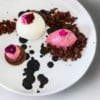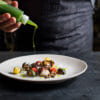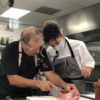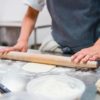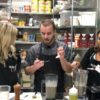Render Me This…A How To Guide

How to Render Animal Fat
So, I wanted to give animal fats some extra love and attention because I so often hear people say “LARD?!?! EEEEW!!” But lard, tallow, schmaltz, bacon fat, and duck fat are all awesome ways to really maximize your meat and also add flavor to your dish. There is disagreement among the different professionals regarding where these fats fall on the health scale. For me, I once again go back to the idea of moderation, and high quality product.
If you have a gorgeous pastured hog that was raised 5 miles down the road from you, it would be a crying shame to not use all its pieces, including it’s fat. Also, just like that butter we talked about, a lot of animal fats take flack for being very high in Omega 6 fatty acids, but pastured (free-grazing animals eating their natural foraged diet) meat and fat actually have a much higher ratio of Omega 3’s and other healthy fats. So if you are a meat eater, get your hands on quality meat and get buck wild…use every last bit of that beautiful animal. Also, fat rendered from meat doesn’t run the same risks of oxidization and heat damage that the vegetable oils do, so it is safe to use at high temperatures.
What are the different kinds of animal fats and how can they be used?
Lard
such an ugly word for such a delicious and versatile product! Lard is rendered pork fat. If you buy fresh fat from a pastured hog, it packs a good punch of good monunsaturated fats and can be used in pretty much any kitchen scenario from savory high heat cooking to goodhomestyle baking.
One thing to beware of, all this good stuff I’m saying about lard only applies to the fresh, pastured product. If you can buy it unrefrigerated, run away. That is a sure sign it has been hydrogenated and is just a trans-fatty mess you don’t want in your kitchen.
If you are buying fat/lard from a butcher, there are two kinds, leaf lard and fatback. Leaf lard is soft and ready to go, so does not need to be rendered in the manner described above, you can just melt it and cook in it, or use it in its firm state for baking, just like butter.
Leaf lard is the best choice for baking because it doesn’t impart any pork flavor, whereas fatback will give a good dash of porkiness to your dish. Fatback needs to be rendered. Fatback is much harder than leaf lard, and can also be chopped and used for sausage making.
Tallow – Beef fat
All your trimmings from large cuts of beef can be rendered in the method described above and used in high heat cooking. It will impart a slightly beefy taste.
Schmaltz
Great way to get a whole chicken to go the extra mile for you. All the skin and trimmings can be rendered and used in cooking other poultry dishes.
Bacon fat
Oh. Yes. Must I say more? After you are done making bacon, just strain the leftover fat, and save it in the fridge. Use it to cook everything that will taste better with bacon flavor And really, what doesn’t taste better with bacon flavor?Remember that kale we were talking about last week? Cook it in bacon fat for a treat that will get even the staunchest anti-vegetable eater devouring cups of kale.
Duck fat
Duck fat can often be bought in the refrigerated section of high end grocery stores, or from local butchers. Once you get a batch going, if you cook duck often, your stash will grow if you are making stuff like duck confit. It can add an elegant taste to otherwise simple dishes, and is a fun way to add pizzaz. You can really use duck fat interchangeably with butter to add flavor depth and a note of intrigue.
How to Render Animal Fat:
The rendering process is the same for pretty much all animal fat. This is a great process if you are wondering how to make usable fat out of leftover beef or pork trimmings, or are breaking down a whole animal like a chicken and you want to get the fat off the skin.
- Start with about a quarter or half inch of water in the bottom of a heavy soup pot or Dutch oven and place the fat, in thin strips or small chunks, on top of that. You can do it “dry” with out water, you just have to stir more often and watch more carefully to keep it from burning. If you have a crockpot, a dry render is super easy on the lowest setting, it will take a long time, but no active work.
- Bring the water to a simmer on medium low heat, stirring every few minutes.
- Hang out. Drink some wine. This will take about an hour or longer, depending how much you are doing.
- As the fat melts, it will make weird noises, don’t worry, but stir a little more often.
- Any little bits of meat that are still attached to the fat will be in the process of turning into “cracklins” which are exactly what they sound like. Crunchy bits of heaven.
- Once the crunchy bits of heaven have all sunk to the bottom, your fat is officially rendered, and you have a crunchy snack waiting for you.
- Strain the fat through a fine mesh sieve, or chinois if you have one.
- Seriously, eat the cracklins. Yum. Or put them in a sandwich instead of potato chips.
- Divide the liquid fat (it will be weird and kind of yellowy looking) into freezer safe containers, like mason jars. Leave some head space.
- Let the jars cool uncovered.
- When the fat is fully cool, it will be pillowy soft and pretty much pure white. Every animal is an individual though, so don’t worry if different batches look different.
- If all your water didn’t evaporate, there will be a small amount of moisture left at the bottom of your jars, poke a hole in the fat and let it drain out or it will make your fat spoil faster.
- Cover and refrigerate for a month or 2, or you can keep the fat in the freezer for up to a year! No yucky hydrogenation needed and you’re in the fat for a year!


